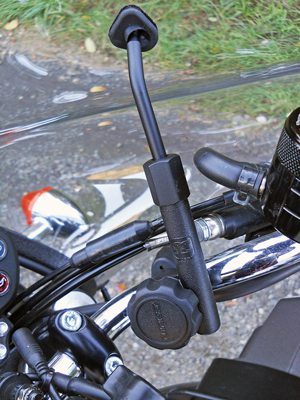Split personalities are nothing new to motorcyclists. Mild-mannered drones by day, toiling away at school or in the office or at the job site, then, as soon as the whistle blows at the end of the day, we turn into two-wheel adventurers. Your bike can reflect that shift in mood, too, with a full-coverage windscreen for commuting that comes off easily on the weekends for more serious riding. National Cycle’s Plexifairing GT throws up a big no-thanks to wind and bugs when you need it, and comes off in a minute when the time is right to face the road’s perils on your own.
The Plexifairing GT is made of DOT-approved, high-impact acrylic, which is more resistant to impacts than standard acrylic. National Cycle says standard acrylic breaks at 1.5 foot-pounds of force, while the high-impact stuff can take a hit of up to 8 foot-pounds before breaking. When you consider that there are harder and heavier things flying around on the road than insects—rocks, for example, thrown up by cars and trucks—that’s a good thing.

The Ballsocket mounting system is what makes it so easy to remove or install the Plexifairing GT. Four sockets on the windscreen—two high and two low—accept aluminum arms with ball ends. National Cycle uses a no-hole technique that chemically bonds the sockets to the acrylic to eliminate the possibility of stress cracks. The upper arms fit into sleeves that screw onto brackets on the handlebar; the lower mounts go on the fork tubes. All the mounting points are secured with threaded knobs you can easily turn by hand—no tools are needed. I can remove the Plexifairing GT from my Triumph Bonneville in about 30 seconds; putting it back on takes a whole minute.
It hasn’t been off the bike much since it arrived, which was just about the time the weather turned cold. I mounted it as high as possible, but I was limited by the Bonneville’s headlight brackets; the hose clamp used to attach the lower mount could go up only so high on the brackets before hitting the “ears” that hold the headlight shell. A bike with bare fork tubes between the upper and lower clamps would allow a higher position. I had to move some cables and wires around on the handlebar to find enough room for the upper mounts, another problem you might not have on another model with a wider, less crowded bar.
When I was done, the top of the screen came up to a few inches below my line of sight, just where I like it. In this position there’s very little helmet buffeting, and not much wind curling around to hit me in the chest. My hands are reasonably well protected, but my forearms and upper arms are in the wind. Raising the Plexifairing might cure that, but there’s the headlight-ear situation….
I removed and replaced the Plexifairing several times while I was adjusting the mounts, and it got easier every time. Now it’s less hassle to take it off to clean the backside than it is to reach around it. The mounts stay put, and the screen has so far resisted scratches and dings that often result from riding some of the gravel-strewn back roads around here.
The Plexifairing GT comes with all the necessary mounting hardware and sells for a suggested retail price of $259.95; some bikes require additional mounting hardware at extra cost.
For more information: Call (708) 343-0400 or visit nationalcycle.com
(This Gearlab review was published in the April 2014 issue of Rider magazine.)








This is a great shield. I have one on my 2005 Victory and absolutely love it.